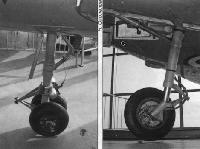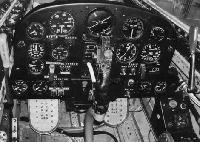
Helwan HA-300
Первым реактивным истребителем, построенным в Египте, был Helwan HA-300, который был спроектирован на базе самолета Hispano HA-300, созданного в Испании коллективом конструкторов под руководством известного Вилли Мессершмитта. Последний предназначался для испанских ВВС, но программа была закрыта в 1960 году, после чего была передана Объединенной Арабской Республике - так до сентября 1961 года именовалось объединенное государство Сирии и Египта, а затем, до 1971 года, так именовался и сам Египет. Специалистов и все оборудование перевезли на завод "Helwan". Спроектированный поначалу под турбореактивные форсированные двигатели Bristol Orpheus BOr. 12, самолет в египетском варианте был уже модифицирован под египетские турбореактивные двигатели E-300, созданные под руководством доктора Бранднера. Было построено три опытных самолета, и первые два из них поднялись в воздух 7 марта 1964 года и 22 июля 1965 года. На первые два прототипа устанавливались двигатели Orpheus Mk 703-S-10 тягой 21,57 кН. Третий опытный самолет с двигателем E-300 прошел только рулежные испытания перед тем, как программа была прекращена в конце 1969 года.
- Описание
Фотографии
-
Aviation Historian 27 / J.Moralez - From Nile Eagle to Nasser's Folly
The first prototype HA-300 on display at the Deutsches Museum’s Flugwerft at Oberschleissheim. After the cancellation of the HA-300 project, the Egyptians turned their attention from developing expensive indigenous aircraft designs to using regional political leverage to acquire state-of-the-art aircraft from the Soviet Union instead.
-
Aviation Historian 27 / J.Moralez - From Nile Eagle to Nasser's Folly
Helwan HA-300 стал настоящим многонациональным самолетом - создавался немецкими конструкторами в Испании, а затем в Египте, но так и не реализовался из-за проблем с силовой установкой.
The two HA-300 flying prototypes were extremely similar, the tell-tale differences between the two being a blade antenna aft of the cockpit on HA-300-01, missing from the second prototype, which incorporated a mass-balance on the rudder; the absence of the former and presence on the latter reveal this to be HA-300-02. -
Авиация и Время 2016-03 / А.Котлобовский - "Мессершмитт" для Насера (Самолет Helwan HA-300)
Опытный самолет HA-300V-1 вскоре после выкатки. 1963 г.
-
Авиация и Время 2016-03 / А.Котлобовский - "Мессершмитт" для Насера (Самолет Helwan HA-300)
Буксировка самолета HA-300V-1 во время наземных испытаний. Хелуан, лето 1963 г.
-
Авиация и Время 2016-03 / А.Котлобовский - "Мессершмитт" для Насера (Самолет Helwan HA-300)
Самолет HA-300V-1 в исходной конфигурации
-
Авиация и Время 2016-03 / А.Котлобовский - "Мессершмитт" для Насера (Самолет Helwan HA-300)
Самолет HA-300V-1 с аэродинамическими гребнями на крыле
-
Авиация и Время 2016-03 / А.Котлобовский - "Мессершмитт" для Насера (Самолет Helwan HA-300)
Самолет HA-300V-1 в испытательном полете над окрестностями Каира
-
Aviation Historian 27 / J.Moralez - From Nile Eagle to Nasser's Folly
The first prototype, HA-300-01, with blade antenna aft of the cockpit and without rudder mass-balances, around the time of its first flight in March 1964. Production examples would have incorporated a revised air intake arrangement, with shock-cones fitted within the intake aperture.
-
Aviation Historian 27 / J.Moralez - From Nile Eagle to Nasser's Folly
One of a series of photographs taken of the second HA-300 prototype at the Helwan works in Egypt, by German journalist and former Messerschmitt Me 163 test pilot Mano Ziegler.
-
Авиация и Время 2016-03 / А.Котлобовский - "Мессершмитт" для Насера (Самолет Helwan HA-300)
Самолет HA-300V-2 вскоре после завершения сборки. Середина 1965 г.
-
Aviation Historian 27 / J.Moralez - From Nile Eagle to Nasser's Folly
The first prototype, without the rudder mass-balance, beside the factory at Helwan.
-
Авиация и Время 2016-03 / А.Котлобовский - "Мессершмитт" для Насера (Самолет Helwan HA-300)
Самолет HA-300V-2 перед очередным полетом
-
Авиация и Время 2016-03 / А.Котлобовский - "Мессершмитт" для Насера (Самолет Helwan HA-300)
Самолет HA-300V-3. Лето 1969 г.
-
Авиация и Время 2016-03 / А.Котлобовский - "Мессершмитт" для Насера (Самолет Helwan HA-300)
Опытный самолет HA-300V-1 в сборочном цехе.
-
Авиация и Время 2016-03 / А.Котлобовский - "Мессершмитт" для Насера (Самолет Helwan HA-300)
Передняя и правая основная опоры шасси
-
Aviation Historian 27 / J.Moralez - From Nile Eagle to Nasser's Folly
The HA-23P glider undertook several towed flights, initially behind a motor car and then with the help of a licence-built Heinkel He 111. The nosewheel left the ground at 180km/h (112 m.p.h.) and the glider took off at 195km/h (121 m.p.h.). The towing cable was then cast off at 200-250km/h (125-155 m.p.h.). The machine was found to be unstable in flight, however, and the Spanish government decided against further development.
-
Aviation Historian 27 / J.Moralez - From Nile Eagle to Nasser's Folly
The HA-23P’s mid-mounted wing was of 20ft 2in (6-15m) span with an aspect ratio of 1.89:1 and an area of 215ft2 (20m2). It was built with a three-spar structure of mixed wood and metal construction and incorporated two boundary-layer fences on each wing to prevent span wise migration of the airflow.
-
Aviation Historian 27 / J.Moralez - From Nile Eagle to Nasser's Folly
The HA-23P, or HA P-300, as it is marked on the fin here, was a research glider built by Hispano at Seville to test the low-speed aerodynamic characteristics of Willy Messerschmitt’s proposed HA-300 lightweight supersonic delta-winged fighter. A removable transparent canopy was fabricated but appears not to have been fitted, and the undercarriage was non-retractable.
-
Aviation Historian 27 / J.Moralez - From Nile Eagle to Nasser's Folly
The fuselage of the HA-23P was constructed in two parts, the forward portion in metal and the rear section of wooden structure. The glider’s length was 33ft 6in (10-2m), which included a tailcone fitted with an anti-spin parachute. The loaded weight of the machine was 2,755lb (1,250kg) with a wing loading of 12-8lb/ft2 (62-5kg/m2).
-
Авиация и Время 2016-03 / А.Котлобовский - "Мессершмитт" для Насера (Самолет Helwan HA-300)
Стендовые испытания двигателя E-300
-
Авиация и Время 2016-03 / А.Котлобовский - "Мессершмитт" для Насера (Самолет Helwan HA-300)
Президент Насер осматривает HA-300V-1
-
Aviation Historian 27 / J.Moralez - From Nile Eagle to Nasser's Folly
The cockpit of the first prototype, now on display at the Deutsches Museum at Oberschleissheim near Munich. The cockpit of the diminutive fighter was “cosy”, being approximately equivalent to the UK’s Folland Gnat. The canopy hinged to starboard.
-
Aviation Historian 27 / J.Moralez - From Nile Eagle to Nasser's Folly
The instrument panel of the first prototype was comparatively simple for a 1960s-vintage combat jet aircraft, although it would have become more complicated as various weapons and navigation systems were added to make the type capable of operating on the Egyptian Air Force’s front line.
-
Jane's All the World Aircraft 1966 / 02 - Aircraft
Drawings of the HA-300 single-seat fighter built at Helwan Air Works
-
Air International 1982-11 / Fighter A to Z
The second prototype of the Helwan-built HA-300 powered by an Orpheus 703-S-10 turbojet and flown in July 1965.
- Фотографии





























